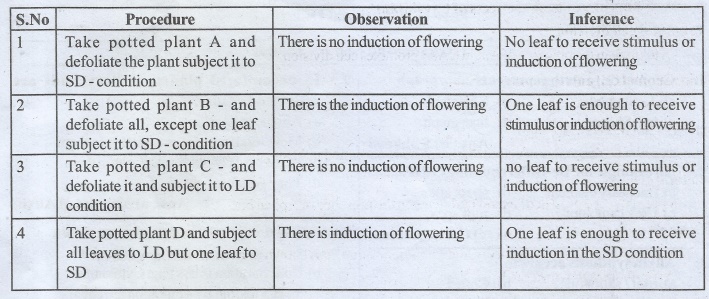Plant Growth and Development | Plant Physiology (Functional Organisation) | Botany - Answer the following questions | 11th Botany : Chapter 15 : Plant Growth and Development
Chapter: 11th Botany : Chapter 15 : Plant Growth and Development
Answer the following questions
Plant Physiology (Functional Organisation)
Plant Growth and Development
6. What are the parameters used to measure growth of plants?
Answer:
Growth in plants can be measured in terms, of
1. Increase in length or girth (roots and stems)
2. Increase in fresh or dry weight
3. Increase in area or volume (fruits and leaves)
4. Increase in number of cells produced.
7. What is plasticity?
Answer:
Plasticity refers to the environmental heterophylly seen in Butter cup plant (Ranunculus). In this aquatic plant, the leaves in the air is normal, where as the leaves submerged under water are highly thin and hairy highly adapted to do carbon assimilation Developmental heterophlly seen in the juvenile plant leaves of cotton and corianter. Where the young leaves have a different shape from the mature leaves is not considered as plasticity.
8. Write the physiological effects of Cytokinins.
Promotes
cell division:
Cytokinin, in the presence of Auxin (IAA) promotes
cell division.
Induction
of cell enlargment:
Associated with IAA and Gibberellins induces cell
enlargement
Breaks
dormancy:
It can break dormancy of certain, light sensitive
seeds and induces germination. Eg. Tobacco
Lateral
growth:
It promotes the growth of lateral buds even in the
presence of Apical bud.
Delays
Aging:
It's application, delays-aging by nutrient
mobilization - It is known as Rich mond Lang effect. Varrious other
activities, such as
1. Increases rate of protein synthesis
2. Induces formation of interfascicular cambium
3. Overcomes apical dominance
4. Induces formation of new leaves, chloroplasts and
lateral shoots
5. accumulation of solutes
9. Describe the mechanism of photoperiodic induction of flowering.
Mechanism
of photoperiodic induction of flowering.
1. The physiological change on flowering due to
relative length of light and darkness (photoperiod) is called Photoperiodism.
2. The photoperiod required to induce flowering is
called critical day length. Eg. 12 hours in Maryland Mammoth Tobacco
Xanthium 15.05 hours.
Photoperiodic
induction :
1. An appropriate photoperiod in 24 hours cycle
constitutes one inductive cycle. Plants may require one or more
inductive cycles for flowering.
2. The phenomenon of conversion of leaf primordia
into flower primordia under the influence of suitable inductive cycles is
called photoperiodic induction. Example: Xanthium (SDP) - 1 inductive cycle and Plantago (LDP)-25 inductive cycles.
Site
of photinductive perception
1. Leaves are the parts that receive photo periodic
stimulus (PPS), again it is only leaves that synthesize floral hormones and
tranlocate it to the apical tip to promote flowering.
2. This can be demonstrated by experiments conducted
in Cocklebur plant. Which is a SD plant. The nature of flower producing
stimulus has been elusive so far. It is believed by phsiologist that a hormone
is responsible for it, Chailakyan (1936) named it as Florigen It
is not possible to isolate it.

10. Give a brief account on Programmed Cell Death (PCD)
Answer: Getting old or aging is called senescence.
1. Senescence is controlled by plants own genetic programme and death of the plant or plant part consequent to senescene is called Programmed Cell Death. In short senescence of an individual cell is called PCD.
2. The proteolytic enzymes involving PCD in plants are Phytapases and in animals are caspases. The nutrients and other substrates from senescing cells and tissues are remobilized and reallocated to other parts of the plant that survives.
3. The protoplasts of developing xylem vessels and tracheids die and disappear at maturity to make them functionally efficient to conduct water for transport.
4. In aquatic plants, aerenchyma is normally formed in different parts ofthe plant such as roots and stems which encloses large air spaces that are created through PCD.
5. In the development of unisexual flowers, male and female flowers are present in earlier stages, but only one of these two completes its development while other aborts through PCD.

Q. What are the physiological effects of plants facing drought condition?
Q. Explain the mechanism of biotic stress.
Related Topics